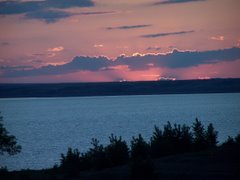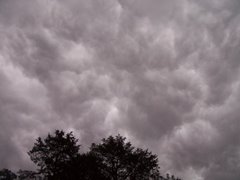We returned to Salome, AZ late last eve after spending 5 days at Morgan Hill visiting our Daughter Chris and her husband David. It was somewhat on the cool side and rainy while we were there. They came out to Morgan Hill and stayed in a rental trailer for 4 nights. That sure did cut down on the driving as it is about 50 miles to their apt. in Redwood City from where we stay in Morgan Hill. We were able to tour Mission San Juan Bautista with them as they hadn't been there for years. We also stopped at Casa Del Fruita about 15 miles east of Gilroy on Rt 152. Casa Del Fruita is a huge fruit & vegetable market that has been expanded over the years to a small amusement part, RV park, Restaurant, and truck stop. Of course mother & daughter got to spend a couple of days shopping together. We left Morgan Hill Fri. morning and drove in steady rain for a couple of hours and then just intermittent showers on down 101 to Paso Robles. We then went east on Rt. 46 to Rt 99 and south to Bakersfield. At Bakersfield we went east on Rt 58 spending the night in Barstow. When we arrived in Barstow the wind was blowing sand and dirt. Sat. morning we drove just north of Barstow to the Calico Ghost Town at Yermo, CA. We spent a couple of hours there and then ate lunch at Peggy Sue's Diner on I-15. Peggy Sue's Diner is an interesting place it is a 50's diner full of 50's memorabilia. It also featured 50's music like you heard from the juke boxes. Our waitress was the typical 50's gum chewing waitress like you saw in the 50's movies. Will have another blog on the Ghost Town. We then proceeded east on I-40 To Thermal, CA. It was then south on US 95 to Parker, AZ then south and east another 6o miles to Desert Palms in Salome. I will have to say that it is a sharp contrast from the now green hills and valleys of western CA to the brown desert of eastern CA and western AZ. But the 10 degree's warmer temp here is sure welcome.
Chris called us yesterday after her first day back to work and said she found out she has another week off later in March and wondered if we wanted to come back then. We told her probably not but I guess time will tell as we have learned not to close any gates until they are behind us.

 Just a few miles north of Barstow, CA is where you will find the Ghost Town of Calico. It was established in 1881. From 1881 until 1907 there were as many as 500 mines producing silver and borax. In 1887 the population was 1200 and included 22 saloons a red light district and China Town. By 1893 the population had dropped to 300 and by 1907 it was a ghost town. At some later time Walter Knott of Knotts Berry farm purchased the town consisting of four original adobe buildings and and a few wood buildings. He rebuilt the town to what you now see and in 1966 donated it to county of San Bernardino. It now has many craft shops that make and sell leather goods, pottery, wood products etc. that would have been consistent with the time that the town existed. There is an old mine that you can still go into as well. In short it is a very affordable tourist trap. The price of admission is $6 a person.
Just a few miles north of Barstow, CA is where you will find the Ghost Town of Calico. It was established in 1881. From 1881 until 1907 there were as many as 500 mines producing silver and borax. In 1887 the population was 1200 and included 22 saloons a red light district and China Town. By 1893 the population had dropped to 300 and by 1907 it was a ghost town. At some later time Walter Knott of Knotts Berry farm purchased the town consisting of four original adobe buildings and and a few wood buildings. He rebuilt the town to what you now see and in 1966 donated it to county of San Bernardino. It now has many craft shops that make and sell leather goods, pottery, wood products etc. that would have been consistent with the time that the town existed. There is an old mine that you can still go into as well. In short it is a very affordable tourist trap. The price of admission is $6 a person.


